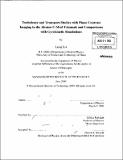| dc.contributor.advisor | Miklos Porkolab. | en_US |
| dc.contributor.author | Lin, Liang, Ph. D. Massachusetts Institute of Technology | en_US |
| dc.contributor.other | Massachusetts Institute of Technology. Dept. of Physics. | en_US |
| dc.date.accessioned | 2010-03-25T15:18:06Z | |
| dc.date.available | 2010-03-25T15:18:06Z | |
| dc.date.copyright | 2009 | en_US |
| dc.date.issued | 2009 | en_US |
| dc.identifier.uri | http://hdl.handle.net/1721.1/53230 | |
| dc.description | Thesis (Ph. D.)--Massachusetts Institute of Technology, Dept. of Physics, 2009. | en_US |
| dc.description | Cataloged from PDF version of thesis. | en_US |
| dc.description | Includes bibliographical references (p. 181-189). | en_US |
| dc.description.abstract | An upgraded phase contrast imaging (PCI) diagnostic is used to study turbulence and transport in Alcator C-Mod. The upgraded PCI system is capable of measuring density fluctuations with high temporal (2 kHz-5 MHz) and wavenumber (0.5-55 cm-1) resolution. An upgrade of the system has enabled PCI to localize the short wavelength turbulence in the electron temperature gradient (ETG) range and resolve the direction of propagation (i.e., electron vs. ion diamagnetic direction) of the longer wavelength turbulence in the ion temperature gradient (ITG) and trapped electron mode (TEM) range. Nonlinear GYRO simulations have also been performed and the predicted fluctuation is compared against experimental measurements through a synthetic PCI diagnostic method. Both L-Mode and H-Mode plasmas are examined through these numerical and experimental methods. The L-Mode experiments were carried out over the range of densities covering the "neo-Alcator" (linear confinement time scaling with density, electron transport dominates) to the "saturated ohmic" regime. The key role played by the ITG turbulence has been verified. In the saturated ohmic regime, the simulated ion and electron thermal diffusivities also agree with experiments after varying the ion temperature gradient within experimental uncertainty. However, in the linear ohmic regime, GYRO does not agree well with experiments, showing significantly larger ion thermal transport and smaller electron thermal transport. | en_US |
| dc.description.abstract | (cont.) Our study shows that although the short wavelength turbulence in the ETG range is unstable in the linear ohmic regime, the nonlinear simulation with k[theta][rho]s up to 4 does not raise the electron thermal diffusivity to the experimental level, where k[theta] is the poloidal wavenumber and [rho]s is the ion-sound Larmor radius. The H-Mode studies focus on plasmas before and during internal transport barrier formation in an enhanced D[alpha], H-Mode plasma. The simulated fluctuations from GYRO agree with experimental measurements in the ITG regime. GYRO also shows good agreement in transport predictions with experimental measurements after reducing the ion temperature gradient (~15%) and adding ExB shear suppression, all within the experimental uncertainty. | en_US |
| dc.description.statementofresponsibility | by Liang Lin. | en_US |
| dc.format.extent | 189 p. | en_US |
| dc.language.iso | eng | en_US |
| dc.publisher | Massachusetts Institute of Technology | en_US |
| dc.rights | M.I.T. theses are protected by
copyright. They may be viewed from this source for any purpose, but
reproduction or distribution in any format is prohibited without written
permission. See provided URL for inquiries about permission. | en_US |
| dc.rights.uri | http://dspace.mit.edu/handle/1721.1/7582 | en_US |
| dc.subject | Physics. | en_US |
| dc.title | Turbulence and transport studies with phase contrast imaging in the Alcator C-Mod tokamak and comparisons with gyrokinetic simulations | en_US |
| dc.type | Thesis | en_US |
| dc.description.degree | Ph.D. | en_US |
| dc.contributor.department | Massachusetts Institute of Technology. Department of Physics | |
| dc.identifier.oclc | 535171379 | en_US |
